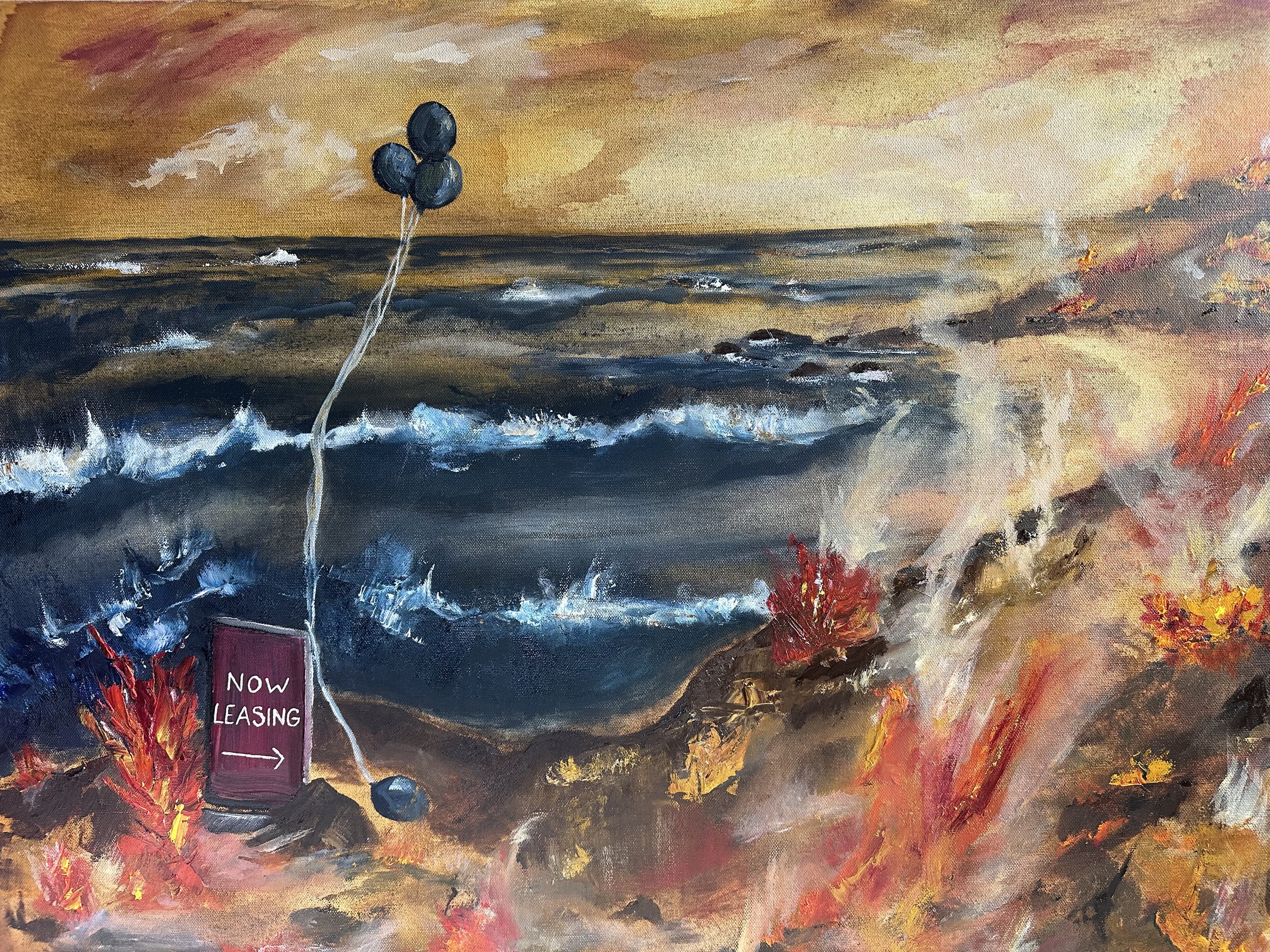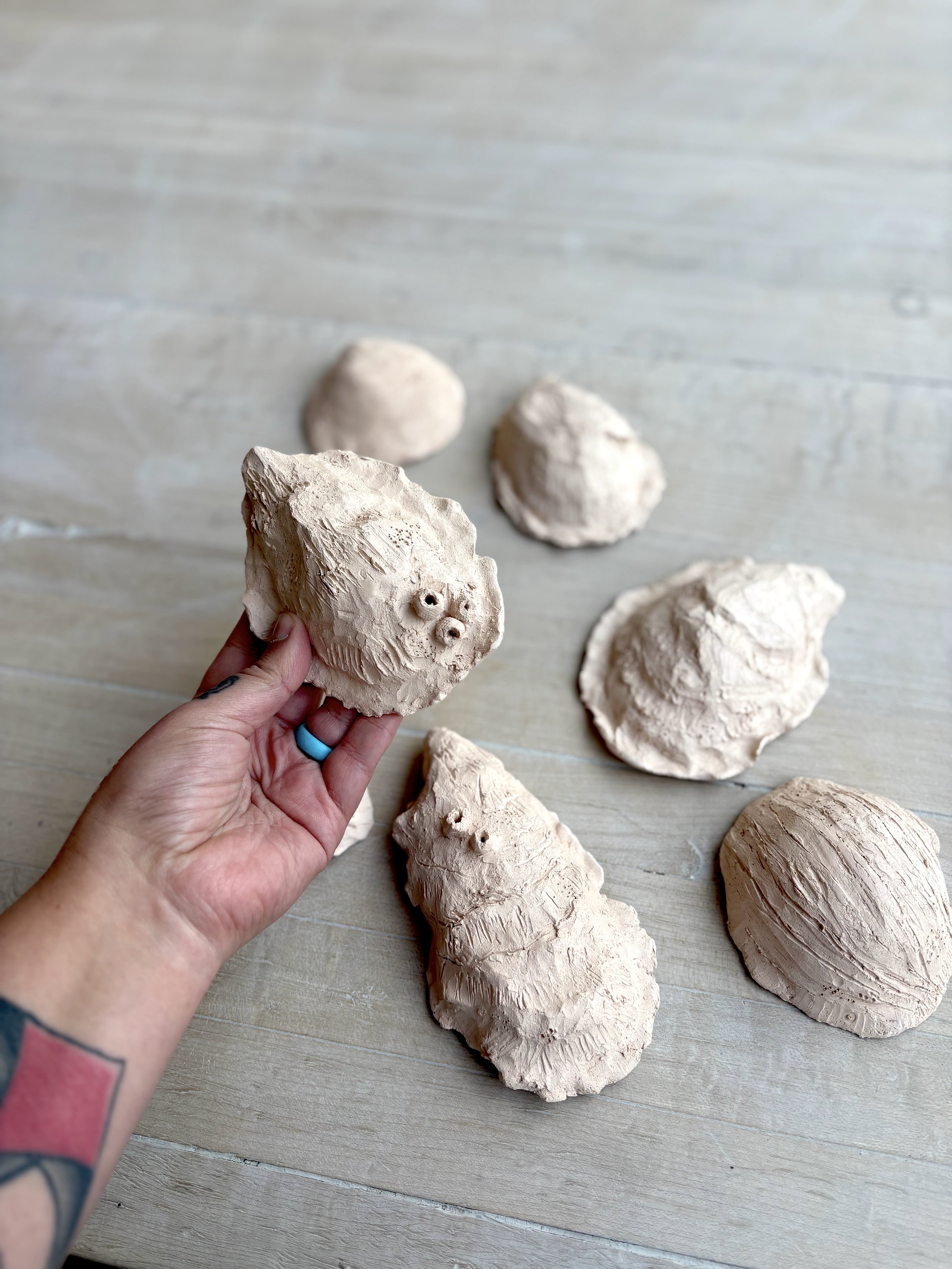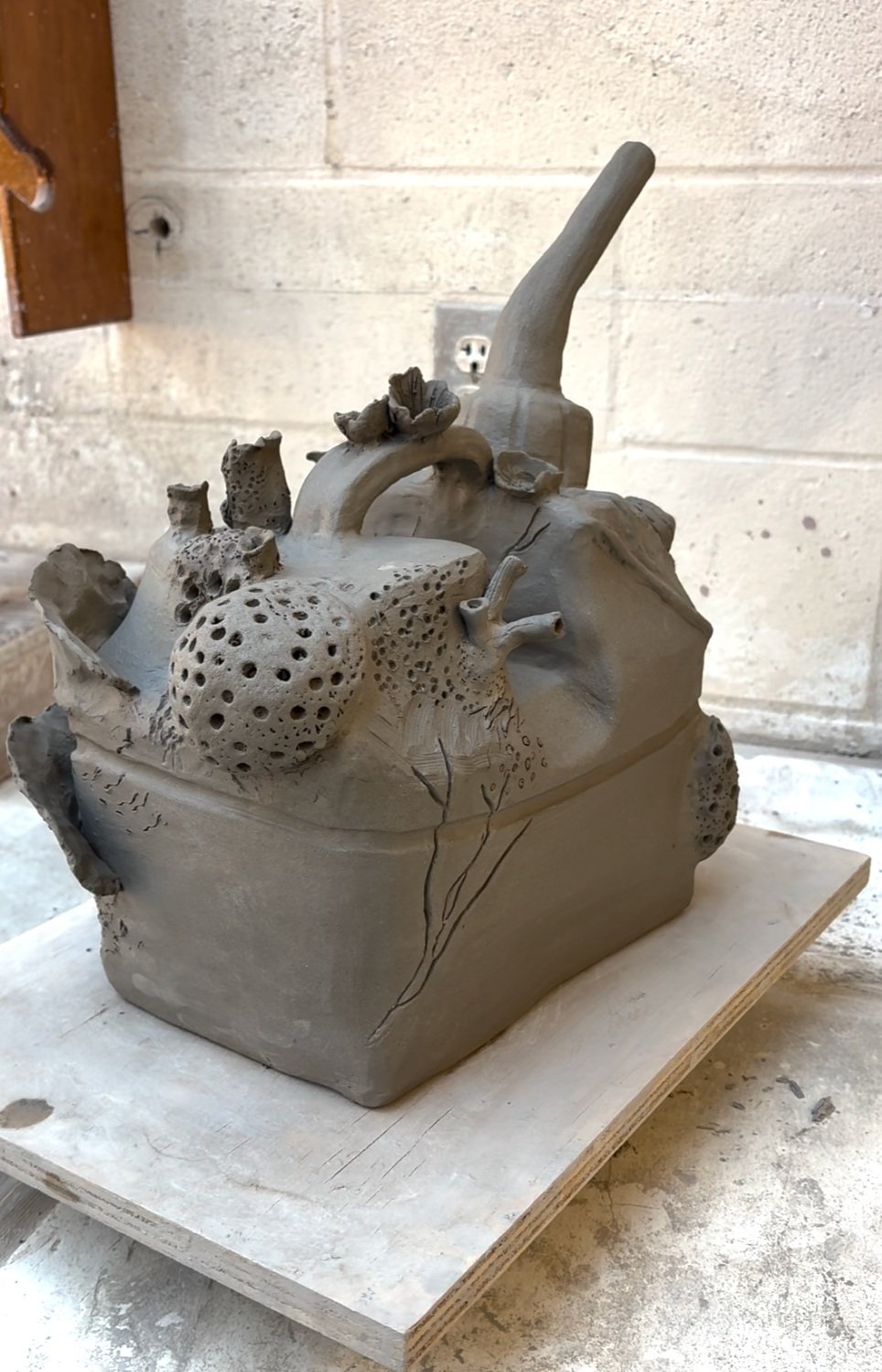Discover the intersection of art, climate activism, and handmade materials.
Explore behind-the-scenes insights, creative processes, and the stories that shape my work.
Hands On Learning
Recaps from workshops, creative tips, and more!
Featured On
Interviews, publications (like Newsday!), and podcasts.
Art Process
What I’m working on.
ART PROCESS: ANDY WARHOL PRESERVE PIGMENT COLLECTION
Rocks and pigments on my desk from the Andy Warhol Preserve in Montauk, New York
I’m proudly introducing the five rocks I sourced from the Andy Warhol Preserve in Montauk, NY.
In October 2024 I had the privilege of teaching a handmade watercolor plein air (outdoor) workshop through a grant provided by The Nature Conservancy, and The Andy Warhol Foundation for the Visual Arts ( @nature.ny & @warholfoundation )
With permission from @nature.ny I carefully selected these five rocks at the private preserve. I’m processing them into fine pigment to turn into paint this spring. The paints will be used as the color basis of a new art collection inspired by the coastal landscape of the Andy Warhol Preserve. This work mirrors my process during my upcoming two month artist residency I will be part of @caumsettfoundation later this summer.
The work is labor intensive - I am literally breaking rocks multiple times over. I will need to grind them, sift them, clean them, dry them, and more. Each time the color passes through my hands I connect more and more with it. This work is a privilege and I don’t take it lightly. I’m grateful to the wisdom of all the paint makers, pigment grinders, conservationists, artists, and indigenous practices that led the path for me to step into this alchemy.
The Andy Warhol Preserve, Montauk, New York
ART PROCESS: UPCOMING ART RESIDENCY
Photo Credit: The Caumsett Foundation, image of the art residency barn studio
Hello Art Residency!
One of my goals is to be part of an art residency. I applied to many, but to be honest not only was I never selected but I don’t think the timing was right.
I loved the concept of doing my first one semi-locally, so I can still sleep in my own bed, but have the experience of working on sight somewhere else. Going back to school really changed the way I approach my work. I’m more comfortable working around others, with interruptions, pushing my creative ideas, and experiencing the process of making art in a space other than my home studios.
I applied to ONE this year, and I am thrilled to share I was ACCEPTED into The Caumsett Foundation’s Artist in Residency program for an 8 week period during August and September. I am going to share more with you as it gets closer but some highlights are:
I will work at Caumsett park, with open studio hours that you will be able to come visit me and see what I am up to
I will host a community workshop, painting en plein air (AKA outside!) with my handmade watercolors, similar to this one
I will create a collection of work focused on the theme Caumsett in Color: A Study of Earth and Texture
A group exhibition with the participating artists the beginning of November
Photo Credit: The Caumsett Foundation, map of the park
As the residency gets closer I will share more, and while I am there I encourage you if you’re local to reach out to see how you can experience this alongside me. Thank you to the Caumsett AIR committee for selecting me for this incredible opportunity.
RESEARCH: Rachel Carson’s Silent Spring Impact on the Environment
THE HOAX WE LIVE THROUGH, Christie Jones, oil on canvas, 2024
After this week’s EPA announcement, I can’t help but reflect on my research paper from Fall 2024 semester about the formation of the EPA and Rachel Carson’s impact on the environment. Remember WHY it was formed, and the steps that led to its formation are important. Part of my intention with my art is to merge it with real research, concrete findings, to be able to depict artwork inspired from this mutual place of both beauty and horror as we experience (in real time) the impacts of climate change on our world. The fact that Lee Zeldin is from Long Island, living in coastal communities and acting in exact opposition of what environmental protections we need is appalling. I spent the past few channeling my anger into art. Art and activism are intertwined in my brain. This is going to be something I share more and more about.
IN PROGRESS CERAMIC SCULPTURE BY CHRISTIE JONES
OYSTERS & CLAMS, ceramic sculpture bisque fired in progress, Christie Jones, 2025
DRILL BABY DRILL, ceramic sculpture in progress, Christie Jones, 2025
DRILL BABY DRILL, ceramic sculpture in progress, Christie Jones, 2025
By the way, my professor wrote a raving recommendation based on this paper, small excerpt below;
“Christie’s ability to utilize all of her strengths places her in elite intellectual territory. Her primary source analyzations are on par with those of experienced historians, and her research of varied historical perspectives sheds new light on narratives that are sinking into unchallenged territories. Furthermore, Christie regularly seeks to gather a more diverse and inclusive understanding of the past by consuming history through the lenses of race, gender and ethnicity. This tenacity for historical comprehension has led to some of the most profound scholarships that I have ever read during my time as a professor.” Professor Fabio Montella, Suffolk Community College.
Rachel Carson’s Silent Spring Impact on the Environment
The topic of climate change entered society’s conversation in the early 1960s in the United States. A variety of factors led to the environment receiving extra attention during this period. One of the leading examples to bring awareness to this issue was the release of Rachel Carson’s book, called Silent Spring in 1962. This book played a critical role in the way citizens and the government responded by protecting and advocating for the health of the environment. In Carson’s book she shed light on the harmful effects of chemicals that did not have regulations. She was educated, and an authority on the topic yet as a woman she was not always respected as a viable source (Taylor).
However controversial, and despite being criticized, her book was a catalyst for change and is now viewed as one of the pivotal pieces of information that impacted society’s interaction with environmental protection. Silent Spring argued the impacts of toxic herbicides and pesticides, like dichlorodiphenyltrichloroethane or DDT, would disrupt the environment which would lead to negative human and wildlife repercussions. Silent Spring addresses the need for environmental protections; yet the gender of the author stymies the progress of the movement.
To set the tone of the early 1960s, it is important to discuss monumental events that contributed to the rise of public awareness. The oil spill in Santa Barbara harbor, the contaminated Cuyahoga River in Cleveland, Ohio that caught fire, and a temperature inversion in the city due to the steel mills of Pittsburgh, Pennsylvania brought public attention and outcry to confront the use of chemicals.
Along with the environmental issues, society in the 1960s still did not have many opportunities for women in roles of leadership. Many women were not pursuing further education. Most women did not have careers. During this time women still needed to open credit cards and bank accounts under their husband’s names. The juxtaposition of Carson; a single, childfree, and educated woman created a constant scrutiny for her life choices, but she did not let that stop her from publishing. Whereas men like John Muir, and long-time Audubon Society president T Gilbert Pearson were writing and advocating for nature for years whether they were educated or not (Taylor). This was not something they had to explain or validate as a topic they could speak about, and they were viewed as experts in this field.
Silent Spring argued the impacts of toxic herbicides and pesticides would disrupt the environment which would lead to negative human and wildlife repercussions. “Carson was an editor at the US Bureau of Fisheries (forerunner of the US Fish and Wildlife Service); as a consequence, she was privy to information about the oceans as well as the effects of pesticides like DDT on wildlife” (Taylor).
As an example, Carson describes streams that became chemical soups, laden with the outpourings of chemical treatment plants. She describes runoff from fields treated with pesticides and chemical fertilizers, killing algae, plant life, fish, and animals. With this book, Carson educated the public about the hazards of environmental contamination and made the case for careful consideration of both short-and long-term impacts of human-generated chemical contamination of our waterways (Dasch).
Unable to keep these things morally or ethically she knew them to be true; Carson wrote Silent Spring. Her book ignited an almost immediate public reaction. It was a New York Times bestseller for 31 weeks (about 7 months) after release between 1962-1963. As a result, Suffolk County, New York residents gathered to sue the U.S. Department of Agriculture over the spraying of DDT. Evidence continued to show that DDT did impact the wildlife and water supply. Residents observed dead fish in ponds, their crops were impacted, and this alarming visual was centered in the lawsuit. Despite the proof, including the artwork portraying the effects on wildlife, and strategically referencing the judge’s own beloved local parks, the rulings did not land in favor of the concerned citizens (The Long Island Advance). The judge acknowledged some of the negative impacts but still did not restrict use of DDT. The legislature to restrict DDT would take another ten years to regulate.
“Carson’s argument was compelling to many Americans, including President Kennedy, but was virulently opposed by chemical industries that suggested the book was the product of an emotional woman, not a scientist” (American Yarp). This poses the question: if Carson were a man, would this information be received differently? “Critics also suggested that Carson, a woman who had no children of her own, did not have any right to speak on behalf of future generations. Yet, childless men like Henry David Thoreau could articulate visions of the future and remain unquestioned. Opponents also mistook the passion and confidence with which Carson wrote as signs of hysteria and irrationality” (Taylor).
“The chemical industry united against Carson, distributing critical reviews and threatening to withdraw magazine advertisements from journals deemed friendly to her. Words and phrases used in the attacks included ‘ignorant,’ ‘biased,’ ‘sensational,’ 'unfounded,’ ‘distorted,’ ‘not written by a scientist,’ ‘littered with crass assumptions and gross misinterpretations,’ to name but a few” (Young). Secretary of the Interior Stewart L. Udall did believe Carson, and he connected her to speaking engagements so that she could continue to share her thoughts from Silent Spring.
Eventually new laws and policies were organized, and changes were made with substantial improvements to the environment that continued into the following decades. Government answers to public outcries were the creation of The National Environmental Policy Act (NEPA) and the Environmental Protection Agency (EPA) were passed by lawmakers in 1969, seven years after Carson’s book was published. In 1970 Earth Day was formed. An annual celebration of protecting our natural resources put pressure on politicians to advocate for citizens requests to protect the planet. “The EPA ceased licensing DDT in 1972” (Stoll).
Unfortunately, Carson passed away two years after Silent Spring was published. She never saw the full impact she had and continues to have in society. She was an outsider, an environmental pioneer and far ahead of the time she was living in. Climate change became recognized as something humans had a role in by either impacting negatively or advocating for policy and regulations.
Through her best-selling books that resonated with many, she inspired a generation to advocate for the planet, and in doing so policies were eventually put in place. Water quality and pollution continue to be an issue for Suffolk County residents and people throughout the nation. The link between government, chemical companies, and her constant point of view being questioned due to her gender makes one wonder if her words were not questioned and initially believed based on her research if some of the impacts from these pesticides and chemicals could have been reduced. DDT is still used in many countries today.
Citations:
"Environmentalism." Gale Encyclopedia of U.S. Economic History, edited by Thomas Carson and Mary Bonk, vol. 1, Gale, 1999, pp. 288-290. Gale eBooks,
link.gale.com/apps/doc/CX3406400286/GVRL?u=sunysuffolk&sid=bookmark-GVRL&xid=622d5aef.
Dasch, Pat. "Carson, Rachel." Water: Science and Issues, edited by E. Julius Dasch, vol. 1, Macmillan Reference USA, 2003, pp. 136-138. Gale ebooks,
link.gale.com/apps/doc/CX3409400053/GVRL?u=sunysuffolk&sid=bookmark-GVRL&xid=3caccf9a.
Hagood, Charlotte Amanda. "Rachel Carson's Silent Spring: Greenovator Spotlight." America Goes Green: An Encyclopedia of Eco-Friendly Culture in the United States, edited by Kim Kennedy White, vol. 1: Thematic Entries, ABC-CLIO, 2013, pp. 109-112. Gale eBooks,
link.gale.com/apps/doc/CX2720700040/GVRL?u=sunysuffolk&sid=bookmark-GVRL&xid=62f143a7.
Richardson, Shaughnessea. “Conquering the Barriers Between Nature and Man: Rachel Carson and the Modern Environmental Movement.” Pennsylvania History, vol. 88, no. 1, 2021, pp. 114–30, https://doi.org/10.5325/PENNHISTORY.88.1.0114.
Stoll, Mark. “The US Federal Government Responds.” Environment & Society Portal, 5 Mar. 2020, www.environmentandsociety.org/exhibitions/rachel-carsons-silent-spring/us-federal-government-responds.
Taylor, Dorceta E. “Rachel Carson – a Woman Ahead of Her Time.” Frontiers in Ecology and the Environment, vol. 19, no. 9, 2021, pp. 487–487, https://doi.org/10.1002/fee.2422.
The American Yawp. “27. The Sixties | the AMERICAN YAWP.” American YAWP, 2018, www.americanyawp.com/text/27-the-sixties/.
“The Long Island Advance 1 December 1966 — the NYS Historic Newspapers.” Nyshistoricnewspapers.org, 2024, nyshistoricnewspapers.org/?a=d&d=lia19661201-01.1.4&srpos=1&e=--1950---1978--en-20--1--txt-txIN-ddt+case-------Suffolk--.
Young, Gerald R. "Carson, Rachel L." Environmental Encyclopedia, 4th ed., vol. 1, Gale, 2011, pp. 268-270. Gale eBooks, link.gale.com/apps/doc/CX1918700260/GVRL?u=sunysuffolk&sid=bookmark-GVRL&xid=90d99bff.













